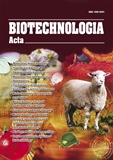ISSN 2410-7751 (Print)
ISSN 2410-776X (Online)

Biotechnologia Acta Т. 18, No. 2, 2025
P. 106-109 , Bibliography 9 , Engl.
UDC: 577.23:[616.36-089.873+615.212.035.3]
doi: https://doi.org/10.15407/biotech18.02.106
ADENYL NUCLEOTIDES CONTENT IN LIVER MITOCHONDRIA OF RATS WITH ACETAMINOPHEN INTOXICATION AFTER PARTIAL HEPATECTOMY
М.S. Ursatyi, H.P. Kopylchuk, I.M. Nykolaichuk
Yuriy Fedkovych Chernivtsi National University, Ukraine
The work aimed to assess the content of adenyl nucleotides (ATP, ADP, AMP) and Atkinson’s adenylate energy charge in the mitochondrial fraction of rat liver with acetaminophen-induced toxic injury following partial hepatectomy.
Materials and Methods. The experiments were carried out on white non-linear rats divided into two groups: I – control rats subjected to resection of 2/3 of the liver tissue and II – rats that underwent partial hepatectomy following acetaminophen-induced toxic injury. Animals were removed from the experiment at 0 (preoperative period), 24, 48, 72, and 168 hours after partial hepatectomy.
Results, In the mitochondrial fraction of the liver in rats with acetaminophen-induced toxic injury after partial hepatectomy, a decrease in ATP content was observed during the three days of the experiment, accompanied by simultaneous increases in ADP and AMP levels during 72 and 168 hours, respectively, against the background of a decline in the adenylate energy charge with minimal values at 72 h of the regenerative period.
Conclusions. Liver regeneration in rats after partial hepatectomy under conditions of acetaminophen-induced toxic injury is accompanied by a quantitative redistribution of adenyl nucleotides in mitochondria: a maximal increase in AMP content occurs alongside a simultaneous decrease in ATP levels at the terminal stage of organ recovery. Such changes cause the most substantial decrease in Atkinson’s adenylate energy charge, which can be regarded as a critical stage in the dysfunction of the energy supply system under these experimental conditions.
Keywords: liver, partial hepatectomy, acetaminophen, adenyl nucleotides.
© Palladin Institute of Biochemistry of the National Academy of Sciences of Ukraine, 2025
References
1. Kiseleva, Y. V., Antonyan, S. Z., Zharikova, T. S., Tupikin, K. A., Kalinin, D. V., Zharikov, Y. O.
(2021). Molecular pathways of liver regeneration: A comprehensive review. World journal of
hepatology, 13 (3), 270–290. https://doi.org/10.4254/wjh.v13.i3.270
2. Bhushan, B., Apte, U. (2019). Liver Regeneration after Acetaminophen Hepatotoxicity: Mechanisms
and Therapeutic Opportunities. Am. J. Pathol., 189 (4), 719–729. https://doi.org/10.1016/j.
ajpath.2018.12.006
3. Sun, R., Zhao, H., Huang, S., Zhang, R., Lu, Z., Li, S., Wang, G., Aa, J., Xie, Y. (2021). Prediction
of Liver Weight Recovery by an Integrated Metabolomics and Machine Learning Approach After 2/3
Partial Hepatectomy. Front. Pharmacol., (12), 760474. https://doi.org/10.3389/fphar.2021.760474
4. Huang, J, Rudnick, D. A. (2014). Elucidating the metabolic regulation of liver regeneration. Am. J.
Pathol., 184 (2). 309–321. https://doi.org/10.1016/j.ajpath.2013.04.034
5. De la Fuente, I. M., Cortés, J. M., Valero, E., Desroches, M., Rodrigues, S., Malaina, I., Martínez, L.
(2014). On the dynamics of the adenylate energy system: homeorhesis vs homeostasis. PloS One,
9(10), e108676. https://doi.org/10.1371/journal.pone.0108676
6. Camici, M., Allegrini, S., Tozzi, M. G.(2018). Interplay between adenylate metabolizing enzymes and
AMP-activated protein kinase. FEBS J., 285 (18), 3337–3352. https://doi.org/10.1111/febs.14508
7. Kopylchuk, H. P., Nykolaichuk, I. M., Ursatyi, М. S. (2024). Age-dependence of biochemical
manifestations of hepatotoxicinjury in rat exposed to xenobiotics of various genesis. Biological
systems, 16(1), 3–13. https://doi.org/10.31861/biosystems2024.01.003
8. Kopylchuk, H., Voloshchuk, O. (2024). Adenine nucleotide content and activity of AMP catabolism
enzymes in the kidney of rats fed on diets with different protein and sucrose content. Studia
Biologica, 18(3), 57–68. https://doi.org/10.30970/sbi.1803.783
9. Mitchell, C., Willenbring, H. (2008). A reproducible and well-tolerated method for 2/3 partial
hepatectomy in mice. Nature protocols, 3(7), 1167–1170. https://doi.org/10.1038/nprot.2008.80
10. Crumm, S., Cofan, M., Juskeviciute, E., Hoek, J. B.(2008). Adenine nucleotide changes in the
remnant liver: An early signal for regeneration after partial hepatectomy. Hepatology, 48(3), 898–
908. https://doi.org/10.1002/hep.22421
11. Kataoka, M., Tanaka, A., Ikai, I., Yamaoka, Y., Ozawa, K., Chance, B. (1993). Kinetic analysis of
ATP-synthetase and ATPase in regenerating rabbit liver. Eur. Surg. Res., 25(2), 91–97. https://
doi.org/10.1159/000129262
12. Wilson, D. F. (2017). Oxidative phosphorylation: regulation and role in cellular and tissue
metabolism. J. Physiol., 595 (23), 7023–7038. https://doi.org/10.1113/JP273839
13. Ramachandran, A., Jaeschke, H. (2019). Acetaminophen hepatotoxicity: A mitochondrial
perspective. Adv. Pharmacol., 85. 195–219. https://doi.org/10.1016/bs.apha.2019.01.007

